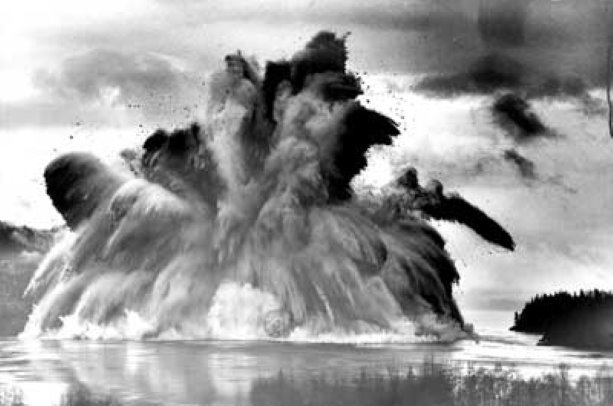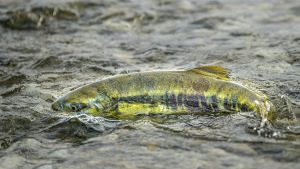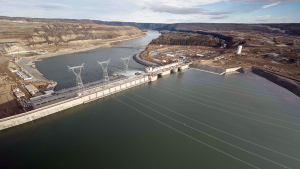Construction photographer Bill Roozeboom was standing only 243 metres away when one of the world’s largest non-nuclear explosions was detonated at Ripple Rock, near Campbell River, British Columbia.
History
Construction photographer Bill Roozeboom was standing only 243 metres away when one of the world’s largest non-nuclear explosions was detonated.
This month, the 87-year-old will return to ground zero, or what’s left of it, to explain the logistics of the engineering marvel that happened near Campbell River B.C. on April 5, 1958. The town is celebrating the anniversary with a day-long festival and an recreation of the explosion.
It took 1,270 tonnes of explosives to tame Ripple Rock, an underwater mountain shaped like two canine fangs that had sent 120 vessels to the bottom of Georgia Straight between Vancouver Island and the B.C. mainland since 1875, with the loss of 114 lives.
The killer twin peaks sat in the midst of Seymour Narrows, the narrowest point in the shipping lanes of the Inside Passage and at low tide they lurked just three metres below the surface.
Two earlier attempts to detonate the fangs were abandoned as incoming tides and strong currents snapped the cables on barges secured over Ripple Rock, while crews were trying to rig the underground mountain peaks with explosives.
In 1953 the National Research Council suggested another approach — come at it from underneath.
Up until that time, tackling Ripple Rock was the biggest project in the history of Canada’s Department of Public Works.
They hired engineering geologist Victor Dolmage and his firm to design the plan of attack.
Dolmage hired Boyles Brothers Drilling, which had a crew of 75 hard rock miners camped out on Quadra Island for 27 months digging a shaft 174 metres (570 feet) deep and then a tunnel 762 metres (2,500 feet) long out under Seymour Narrows.
When they got below Ripple Rock they drilled two vertical shafts 91 metres (300 feet) up into both canine fangs.
Within the pinnacles hundreds of holes called coyotes were drilled and then packed with 1,270 tonnes of Nitramex 2H explosives.
Roozeboom watched it all up close and personal.
He was hired by Dolmage to film a documentary about all aspects of the project.
“The tunnel was only five feet high and I spent months down in there working in a crouched over position, dragging our electric cables through the constant dripping water,” said Roozeboom, who stood more than six feet tall.
“The wet environment kept shorting out our lights and we’d have to stumble through the dark to find the short, which was usually a bad cable connection in a puddle.”
In addition to his work deep below Seymour Narrows, Roozeboom filmed various tests to see what could ignite the explosives.
“We drove bulldozers over the Nitramex. We shot it with high powered rifles, tried to set it on fire, shock it with static electricity, etc., but the only thing that would trigger this stuff was something called Primacord,” he said.
Roozeboom added that as D-Day (detonation day) approached, rumors ran wild up and down the coast about what could happen with the explosion.
It was rumoured that Campbell River, 40 kilometres away from the blast site, would be flattened, a tidal wave would cause severe damage in Japan and millions of fish and whales would die.
“There was even talk that the explosion would cause the big one — where an earthquake drops B.C. into the Pacific,” he recalled.
CBC broadcast the explosion live at 9:31 a.m. on April 5. Dolmage pushed the plunger down and 635,040 tonnes of water and rock were hurled 304 metres (1,000 feet) into the air.
A 7.6-metre (25 feet) tsunami soon dissipated and few fish were reported dead.
Ripple Rock now rests 14.3 metres (47 feet) below the surface at low tide.
Roozeboom was one of the closest people to the blast. A small bunker had been cut into the rock face of Quadra Island for him and a CBC cameraman, but he failed to get his shot.
“The bunker had an overhang and we could only see the first 100 feet of the explosions massive ball of water and debris,” Roozeboom said. “Luckily I had set up another remote camera about a mile down the channel and it caught the whole thing.
“We didn’t even hear a roar or a bang. It was more like a ripping noise. The water muffled much of the noise.”
The removal of Ripple Rock opened up the Inside Passage to Alaska cruises.
More than 20 large cruise liners sail past Campbell River each day during peak cruise season. The ships leave Vancouver and Seattle at precise times, so that they arrive at Seymour Narrows at slack tide.
Even they can’t handle the fast currents that still rip through the narrow passage.











Recent Comments
comments for this post are closed